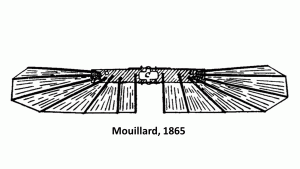In 1865, as a young man living on a farm in Algeria, Mr. Mouillard would often go out into the fields to experiment with a set of wings he’d built, out of sight of those who might make fun of him. Today we would recognize his apparatus as a proto-hang glider, although unlike modern gliders, the operator of this device stood straight up in the space marked C.
 He didn’t have much luck at first. Then one day, after several failed attempts to fly, a sudden gust of wind picked him up and carried him along roughly 12 inches off the ground. This unexpected success scared him witless, and afterwards he wrote “oh horrors!… my feet did not come down to earth! I was skimming along without the power to stop.” Apparently in his enthusiasm to fly he’d neglected to include any sort of mechanism for slowing down, steering, or landing the thing.
He didn’t have much luck at first. Then one day, after several failed attempts to fly, a sudden gust of wind picked him up and carried him along roughly 12 inches off the ground. This unexpected success scared him witless, and afterwards he wrote “oh horrors!… my feet did not come down to earth! I was skimming along without the power to stop.” Apparently in his enthusiasm to fly he’d neglected to include any sort of mechanism for slowing down, steering, or landing the thing.
The wind eventually subsided and he returned to terra firma, breaking his wings but fortunately leaving his body intact. He breathed a big sigh of relief and immediately measured the distance between his take-off and landing spots, which he determined to be 138 feet.
Incidentally, that’s 18 feet longer than Orville Wright’s first flight.
LESSON: Plan ahead and have some idea of what to do if things succeed. Also, once you’ve recovered your wits from the horror of success, be sure to measure your flight.